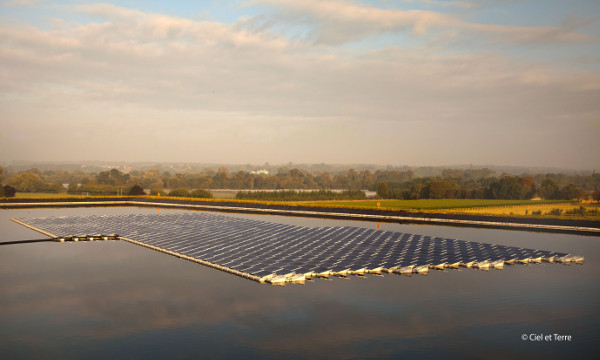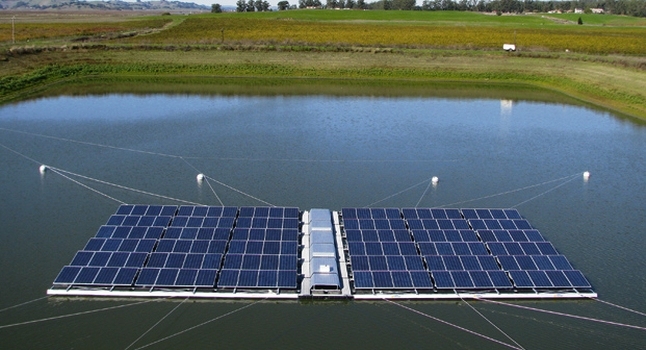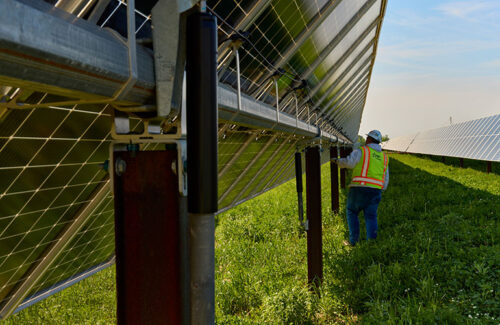你需要知道怎样在水面上安装太阳能电池阵列
位于美国的“水面光伏”太阳能电站是浮在水面上的,这种新的光伏安装趋势正席卷全球。
在水体附近的大型电力电站的客户,如水处理设施,可以通过使用相邻的浮动装置安装太阳能发电节省数十万美元,每年。由于对水体没有得到充分利用租赁付款可能比土地租金较低,相对于其他能源的浮动安装可能会更具竞争力。此外,水体的业主可以通过租赁水面给太阳能开发商或公用事业公司,获得适当受益。

目前,水面光伏项目在许多国家,如新加坡和日本,具有充足的水源上漂浮阵列项目,也有少数安装在美国,但在竞争激烈的全球,市场的领导者是日本。作为一个岛国,没有一个很大的空间来构建陆上阵列。相反,继美国的领先优势,日本开始漂浮的太阳能电池阵列城市附近。
水基太阳能电池阵列的优点是它们可以在几乎任何水体,池塘,湖泊,运河和水库存在。随着世界人口变得越来越大,土地越来越稀少,水面光伏正在变成一个可行的方案。在这里,你必须在安装水面光伏系统之前,需要考虑三件事情。

确定水的构成
首先明确水面光伏电站是漂浮在河流或湖泊的中间,这就是为什么需要特性的浮动的支架。它必须有足够的力量支撑面板,但具有足够的灵活性来处理可高达3.28尺的波浪,同时要保持阵列免受伤害。目前领先的水面光伏支架提供商是法国一家公司(英文“天与地”),它提供了全球绝大多数的支架。国内有山峰新能源可提供水面专业支架。
浮动的太阳能电池板必须保持至少距离水面3英尺以上,同时不应该与高盐度水接触。甚至在水中具有低的盐含量(不超过15个实际盐度单元(PSU)),水可降解支架和组件的组分,从而导致发电量降低。
同时确保配线及电缆被隔离,绝缘防止被淋湿也是必不可少的。至少需要距离水面1.6 英尺。

挑选完美的组件
当涉及到与水接触的阵列,并非所有的面板都是一样的。如果他们没有专为防水,你会发现自己陷入困境。
安装在浮动阵列的所有模块应该有适当的防护等级(IP)等级的连接器和接线盒。 IP等级有助于产品耐归类到水侵入超越作为模糊的说法“防水”。大多数太阳能模块都有一个IP等级,可以保护他们免受“泼水”(IP64)一路淹没在3.28英尺的水30分钟(IP67)。 REC太阳能模块的IP67防护等级。美国国家电气制造商协会定义了NEMA标准编号250 NEMA外壳类型。
板在这些环境中的关键部件是密封剂。许多面板厂商不关注他们的密封剂,因为他们不打算做水性的安装。但是,对于海洋的阵列项目经理必须调查这是封装板有什么它的IP等级是。没有什么能够破坏声誉比以前降低投资者收回投资的阵列更快。

把鸟拒之门外
鸟只需要两样东西生存:水和食物来源。当浮动电站出现后,这意味着你会经常发现水鸟在附近筑巢,成群包围。而且如果鸟粪落足够多在阵列上,它可以减少电力生产。
防止污染的最简单方法是保持鸟远离阵列,可以采取脉冲捕网,尖针或脉冲的形式,提供一个小电击(没有足够的伤害他们,就足以使它不舒服) 。最好是使用尖针或网,虽然网更好,因为尖峰不得不放弃阴影阵列上,并降低功率输出。
当然,如果鸟在阵列里筑巢,就变成一个操作和维护的问题。你需要让人们或机器进到阵列,以保持面板的清洁。目前还没有最好的做法。
最后,如果你注意这三个准则,你可以安装一个成功的“水面光伏项目。这对于美国的太阳能产业是一个崭新的增长前沿。
原文:
What you need to know to create a solar array on the water.
A new trend in photovoltaic arrays sweeping the world and slowly finding a home in select regions of the United States is “floatovoltaics”—a solar array that floats on water.
Heavy power users near bodies of water, like water treatment facilities, could save hundreds of thousands of dollars per year by using electricity generated by an adjacent floating solar installation. Since lease payments for underutilized bodies of water are likely to be lower than land lease payments, a floating installation could be even more competitive compared to other energy sources. Additionally, owners of bodies of water could benefit from modest revenue streams by leasing their water surface to solar developers or to utilities.

Currently, floatovoltaic projects are popular in countries like Singapore and Japan, which have ample water resources on which to float arrays, but the market is growing worldwide.
There are a handful of installations in the United States now, but the clear leader in the market is Japan. As an island (and a smallish one at that), there’s not a lot of room to build land-based arrays. Instead, following the United States’ lead, the Japanese started floating solar arrays near cities.
The beauty of water-based solar arrays is they can exist in almost any water body—ponds, lakes, canals and reservoirs. As the world population becomes ever larger and land becomes scarcer, floatovoltaics are turning into a viable option.That’s why it takes the right equipment—from panels to wiring to platform to aftercare—to ensure the array produces as intended. Here are three things you must consider before installing a floatovoltaic system.
Keep components above water
It might be counterintuitive to think of an electricity-generating plant floating in the middle of a river or lake. After all, if you stand in a puddle and touch an open circuit, you won’t live long.
That’s why special racking is required for floating arrays. It must have the strength to hold panels in place but be flexible enough to deal with waves that can reach up to 3.28 ft, all the while keeping the array safe from harm. The current leader in floatovoltaic racking is a French company called Ciel et Terre (“Heaven and Earth” in English), and it has provided the racking for most current floating arrays worldwide.
Floating solar panels must stay at least 3 ft above water and should not be installed on water with high salinity. Even in water with a low salt content (no more than 15 practical salinity units (PSU)), water can degrade components, leading to lower production.
Keeping wiring and cables from being splashed and corroded is essential. Make sure they are isolated, insulated and at least 1.6 ft above the water.
Pick the perfect panels
When it comes to water-bound arrays, not all panels are created equal. If they are not designed specifically to be waterproof, you could find yourself in trouble.
All modules installed in floating arrays should have the proper ingress protection (IP) rating for the connectors and junction box. The IP rating helps classify products resistant to water intrusion beyond the vague statement of being “waterproof.” Most solar modules have an IP rating that can protect them from “splashing water” (IP64) all the way to submersion in 3.28 ft of water for 30 minutes (IP67). REC solar modules are IP67 rated. The National Electrical Manufacturers Association defines NEMA enclosure types in NEMA standard number 250.
The key component of panels in these environments is the encapsulant. Many panel manufacturers don’t pay close attention to their encapsulants because they are not planning to do water-based installations. But project managers for marine-based arrays must investigate which encapsulant the panels have and what its IP rating is. Nothing can destroy reputations faster than arrays that degrade before investors recoup their investments.
Keep the birds at bay
Birds only need two things to survive: water and food sources. While floating arrays don’t have the latter, they are by definition surrounded by the former—which means you will often find flocks of waterfowl nesting nearby. And if there is enough guano on the array, it can prevent electricity production.
The easiest way to prevent soiling is to keep birds off the array in the first place, which can take the form of bird spikes, netting and strips that provide a little electric shock (not enough to harm them, just enough to make it uncomfortable). On floating arrays, most owners use bird spikes or netting, although netting is better because the spikes have the potential to throw shadows on the array and degrade power output.
Of course, if the birds do soil the array, the problem becomes an operations and maintenance issue. How do you get people or machines out to the array to keep the panels clean? There is no best practice at the moment, but REC is in the process of putting together a manual to standardize the process.
In the end, if you pay attention to these three guidelines, you can install a successful “floatovoltaic” project. It’s a brave new frontier for the solar industry in the United States, but it is growing. It’s something the best installers will know how to do if they want to grow.












